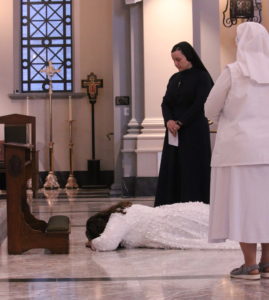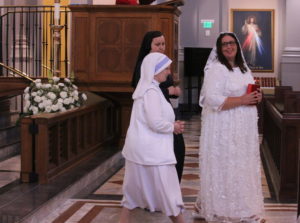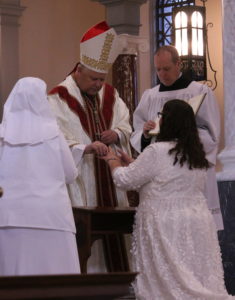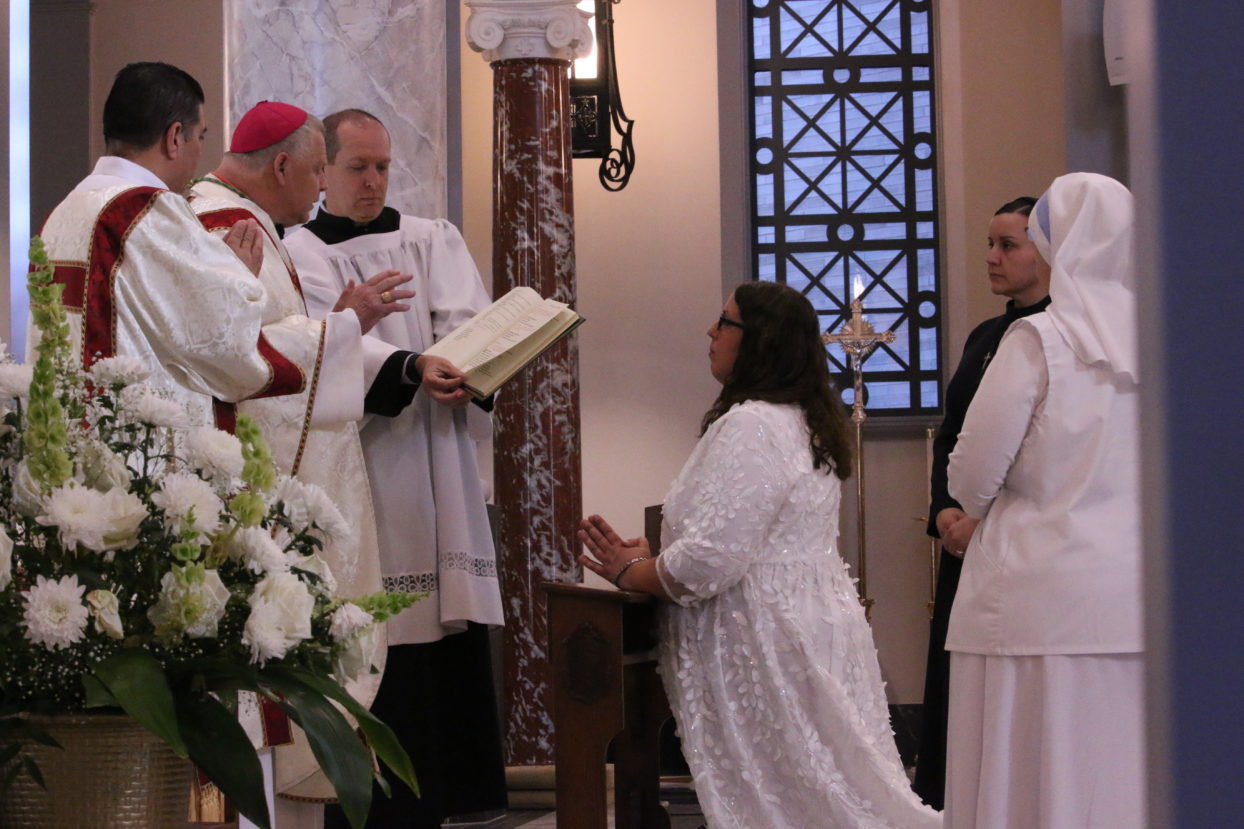Diocese of Knoxville’s new consecrated virgin dedicates her life to Christ, Church
By Emily Booker
Julie Radachy knew from an early age that she would one day be a bride of Christ.
“This has kind of been an ongoing call for me,” Miss Radachy said. “I knew when I was going to receive my first Holy Communion, which was in third grade, that I was going to be a bride of Christ. Everybody told me, ‘Oh, the next time you wear white you’re going to be walking down the aisle getting married to a guy, and you’ll have a family,’ and all those things that a lot of women do. And that, too, is a beautiful vocation. But I knew that my vocation was different. I didn’t really understand it at all at that point. It was just one of those little seeds God planted.”
On April 23, that call was fully realized as she was solemnly consecrated to a life of virginity at the Cathedral of the Most Sacred Heart of Jesus.
A consecrated virgin is considered a “bride of Christ,” meaning that she freely offers herself and all the love she would have given to a husband and children, to Christ.
Consecrated virginity is actually the oldest form of consecrated life in the Church, predating religious orders by hundreds of years.
In the early Church, women would forswear marriage and offer their virginity to the Lord and service to the Church. It was a grand sacrifice and a radical gesture at the time, contradicting the pagan culture’s views of sexuality or societal expectations of women. As it still is in today’s world.
“It’s such a counter-cultural vocation because in today’s society—and sometimes in ancient times—virginity has not been something people have been proud of; it’s almost a humiliation,” Miss Radachy said. “To be able to have that vocation and be able to respond to the call is just really beautiful.”
Consecrated virginity declined as religious orders arose in popularity over the centuries. But there has been a small, recent resurgence since the Second Vatican Council revised the Rite of Consecration and the Order of Virgins was restored as a distinct form of consecrated life in 1970.
According to canon law, consecrated virgins make a commitment to follow Christ more closely, and are consecrated to God by the diocesan bishop, betrothed mystically to Christ, and dedicated to the service of the Church.
There are currently around 3,000 consecrated virgins in the world. They hold jobs and provide for their own needs. They do not live together as religious orders do, but as members of the Order of Virgins, they do associate with one another and pray together. Miss Radachy noted that their online meetings provided her a place to learn more and meet other consecrated virgins as she was discerning the vocation.
Called to be His bride
Although Miss Radachy, 42, who works as an online teacher and real estate agent in Knoxville, knew that she was to be a bride of Christ, it took her a long time to discern exactly what that meant and what her vocation truly would be.
In her early 20s, she wanted to pursue looking into religious orders, but a health setback prevented that at the time.

Julie Radachy lays prostrate as the Litany of the Saints is sung during her consecration to a life of virginity.
“I had talked with my mom at that point because I started feeling this call from God,” she said. “I started talking to her about religious life, and she said, ‘I know why you want to do it. It’s beautiful, but you’re not healthy enough to do that,’ which was completely true. I just kept going through the journey.”
After her mother died in 2015, Miss Radachy began attending daily Mass and the holy hour before Mass at her local church in Ohio. She kept feeling a pull, but she wasn’t sure to what.
Shortly after, she moved to Knoxville and became a parishioner at the cathedral. She also began exploring a religious vocation again. She visited a couple of religious orders. And although she did not join an order, it was these visits and conversations with religious Sisters that helped her find her call.
“The second monastery I went to, a Carmelite one, I was invited back,” she said. “It was really hard for me to say no, because I really loved the Sisters there, and in many ways I could see myself there.
“But I had the opportunity to ask them a lot of questions, and one of the things I asked was, ‘There’s so many orders; how do you know where you fit?’ And they said to think about the saints that you love. I love the Carmelite saints; I definitely have that charism as well. … But I also love the virgin saints.”
She cited St. Lucy, St. Agnes, and St. Cecilia specifically as some of her favorite saints.
While she had heard of consecrated virgins before, Miss Radachy had never given it much thought. But while preparing for her visit to the Carmelites, she ran across a page about a consecrated virgin in their diocese.
“It’s not like it was foreign to me but there was something about seeing it there that I was just kind of like drawn to it,” Miss Radachy said.
“So, then I started reading about consecrated virginity. When I did, it was like reading my life back to myself. Like this is what I’ve been living my whole entire life.”
Still, she wasn’t sure if this was truly her call. She began a formation process with Sister Mary Charles Mayer, RSM, who at the time was the associate chancellor for pastoral services and delegate for consecrated life for the Diocese of Knoxville. But she also began discerning with the Secular Carmelites, a community of laypeople who take vows of Carmelite spirituality.
A notable difference is that consecrated virgins are ecclesiastical, formally connected to the Church through the bishop, who confers the consecration, whereas Secular Carmelites are not.
Miss Radachy noted that while some consecrated virgins are also members of third orders religious, she knew that for her, she had to make a choice.
“For me, I had to make a decision. I kept thinking about it, and the more I kept thinking about it, praying about it, talking to people who are way wiser than I am and way more objective, I realized Secular Carmelites was always my will, and consecrated virginity was God’s will. So, having the choice between the two, I definitely want to live in God’s will for my life.”
‘A woman of great faith’
Bishop Richard F. Stika celebrated the Mass for consecration. Father Ray Powell, Miss Radachy’s spiritual director, concelebrated.
“Today, we celebrate a very beautiful moment in the life of the diocese and the life of the Church universal, for a member of this diocese, Julie Ann Radachy, will make a commitment to the consecration of a life of virginity,” Bishop Stika said.
“She comes from God’s holy people, from your own family. She is a daughter. She is your sister. And she is joined by the ties of family and friendship. God has called her to be more closely united to Himself and to be dedicated to the service of the Church and of the world. Her consecration is a call to greater fervor and spreading the kingdom of God and in giving to the world the spirit of Christ. Think of all the good that will accomplish in her prayers, in good works, and in the abundant blessings that she will obtain from God for all of us, the Church.”

Julie Radachy clutches her copy of the Liturgy of the Hours as she exits the sanctuary of the Cathedral of the Most Sacred Heart of Jesus with Sister Anunziata Grace (light habit) and Sister Maria Juan Anderson, RSM (dark habit).
During the homily, Bishop Stika talked about the grace of the vocation of consecrated virginity and how it reflects the state of the Church and the kingdom of God.
“Our Lord Himself taught us the high calling of such a life consecrated to God and chosen for the kingdom of heaven,” he said. “By His whole life and especially by His labors, the teaching of Jesus, and above all by His paschal mystery, He brought His Church into being. He desired it to be a virgin, bride, and mother: a virgin to keep the faith whole and entire, a bride to be one with Him forever, and a mother to raise up the family of the Church.”
Bishop Stika pointed out that people are called to serve in the Church in all sorts of ways, through different vocations. Each is important and integral to the community of faith.
“All of us are called to certain principles: charity, chastity, forgiveness, mercy, kindness. We’re all called to those things. And we’re called to those things in a particular way of life,” he said.
“Now some people do it all their life as a single person. They’re committed to just being a single person; that’s their call. Others do it as a celibate, like myself. We’re called to that for the sake of the kingdom of God. Other people are called to the beautiful state of marriage, where two become one. …Some people live life in a religious community, like the Sisters of Mercy of Alma or the Dominican Sisters or other religious communities. They live in community. They share in community. Here in the diocese, we also have a hermitess.
“You see, the Church has all these beautiful stones in the crown of salvation that glisten and proclaim that witness. And now my sister here is making that commitment. …She’s a woman of great faith called by the Eucharist to make a proclamation for all of you, to pray for you. She will pray the Liturgy of the Hours; she will pray before the Blessed Sacrament. She consecrates her life for the Church, to pray for all the needs of the Church, needs that are known by you and needs that are only known by God. And she makes this profession freely, to be in a life of grace.
“She will pray for those in the single state or in the celibate state or in the married state, sometimes in the confusion state as well. She makes this commitment because God has called her to this moment. Let us rejoice in that, especially on this weekend in which we celebrate ‘Jesu, confideo in te,’ ‘Jesus, I trust in you,’ the weekend of mercy. Always trust in Jesus, and He will take you to the place where He wants you to be.”
Then the bishop addressed Miss Radachy directly.
“Today, through my ministry as bishop, [the Holy Spirit] anoints you with a great new grace and consecrates you to God by a new title. He gives you the dignity of being a bride of Christ and binds you to the Son of God in a covenant to last forever.
“I pray that you make your whole life reflect your vocation and your dignity. Our holy mother, the Church, sees in you a chosen company within the flock of Christ. Through you the Church’s motherhood of grace bears its abundant fruit.
“You have renounced marriage for the sake of Christ. Your motherhood will be a motherhood of the Spirit as you do the will of your Father and work with others in the spirit of charity so that a great family of children may be born or reborn to the life of grace. Your joy and your crown, even here on earth, will be Christ, the Son of the virgin Mary and the Bridegroom of virgins. He will call you to His presence and into His kingdom, where you will sing a new song as you follow the Lamb of God wherever He leads you.”
Following the homily, Miss Radachy entered the sanctuary with her attendants, Sister Anunziata Grace, the hermitess in the diocese, and Sister Maria Juan Anderson, RSM.
Miss Radachy later pointed out how the three women lived out different vocations but bonded over their shared desire to live lives pointing toward the kingdom of heaven.
Unlike those joining religious orders, consecrated virgins do not take vows. Rather, they make a propositum (promise) to live in a state of chastity for the rest of their lives. They then receive consecration from the bishop.
As part of the consecration ceremony, Bishop Stika asked Miss Radachy a series of questions:
“Are you resolved to persevere to the end of days in the holy state of virginity and in the service of God and his Church?
“Are you so resolved to follow Christ in the spirit of the Gospel that your whole life may be a faithful witness to God’s love and a convincing sign of the kingdom of heaven?
“Are you resolved to accept solemn consecration as a bride of our Lord Jesus Christ, the Son of God?”
After each question, Miss Radachy responded, “I am.”
Miss Radachy then prostrated herself before the altar as the Litany of the Saints was sung. Following the Litany of the Saints, Miss Radachy knelt before Bishop Stika and made her statement of intention:
“Father, receive my resolution to follow Christ in a life of perfect chastity, which, with God’s help, I here profess before you and God’s holy people.”

Bishop Richard F. Stika presents the veil and ring that are the insignia of Julie Radachy’s consecration. Bishop Stika told Miss Radachy to keep her fidelity to her Bridegroom unstained, “and never forget that you are bound to the service of Christ and of His body, the Church.”
Then Bishop Stika extended his hands over her and recited the prayer of consecration.
Upon receiving consecration, Miss Radachy was then presented with a veil and a ring.
“Receive the veil and ring that are the insignia of your consecration. Keep unstained your fidelity to your Bridegroom, and never forget that you are bound to the service of Christ and of His body, the Church,” the bishop said.
The ring was Miss Radachy’s late mother’s wedding ring.
The bishop also presented her with a book of the Liturgy of the Hours, which she will now pray every day.
“Receive the book of the Liturgy of the Hours, the prayer of the Church. May the praise of our heavenly Father be always on your lips. Pray without ceasing for the salvation of the whole world,” he said.
Following Mass, a reception was held in the cathedral hall.
‘There’s so much joy’
So, what does the life of a consecrated virgin look like?
To the outsider looking in, Miss Radachy’s life may not look that different. But to her, there has been a change.
“I’m still very much living in the world. I still have the same jobs and people that I’m working with. Yet, it’s all very different, because there’s this new purpose to my life. I really am pointing to the kingdom of God with everything that I do and every interaction that I have with people now. I’m always thinking about how I can bring God to people—not like hit them over the head with it, but just in the way that I conduct myself.”
Every consecrated virgin lives out her vocation a bit differently. Her career, community, and charisms shape how her vocation looks. Miss Radachy continues to find value in the Carmelite tradition.
“That’s one of the neat things about consecrated virginity, too, that there are different charisms that you can have. It’s very easy for me to bring that Carmelite spirituality into my life,” she said.
She also attends daily Mass and regular adoration and prays the Liturgy of the Hours.
“The Eucharist of course is the source and summit for all Catholics, but for consecrated virgins it’s also the center of our lives,” she noted.
To help her live out her promise to serve the Church, she developed a rule of life, with the help of Mother Timothea Elliot, RSM, and Father Powell. The rule guides her and is rooted in the four pillars of consecrated virginity: prayer, penance, apostolic ministry, and works of mercy.
She has chosen to specifically pray for people who are physically or spiritually at risk.
“That includes priests and seminarians, souls in purgatory, conversion of sinners and salvation of souls, and also for the unborn and their mothers,” she explained. “Those are just kinds of things I’ve always prayed for. It’s kind of natural that it works into my life that way.”
She also is very involved in her parish, reading at Mass or arranging altar flowers.
“What I try to do with all these different things that I do is follow St. Paul’s advice about praying unceasingly. When I’m doing flowers, for example, if there’s a wedding coming up, I’ll pray for the couple getting married, that they’ll have a successful marriage. Things like that. I try to make everything I do a prayer to God.”
For someone who has promised her virginity to God and the Church, the church family becomes even more important.
“I’ve always been more drawn to the parish family,” Miss Radachy said. “I’ve just always seen them as my family, even from being a kid. I just always felt that family environment in the parish, even now. It’s like it is my family. It is my family.”
But it’s more than just the tight bonds of a parish community. As a consecrated virgin and a bride of Christ, Miss Radachy also has assumed the role of spiritual mother. And she finds that this form of motherhood is what best suits her.
“The vocation itself, we are all spiritual mothers to the Church,” she said. “You know, I’ve been a teacher for many years, too, so I always call my students my kids. So, in many ways with this vocation, it’s kind of like that. I have the ability to be the spiritual mother for the Church. Not to decrease marriage and the family because that, too, is super important—but I have that fulfillment in being a spiritual mother for the Church.”
As Bishop Stika noted, the Church has different, beautiful stones in the crown of salvation. Every vocation makes the Church stronger and shine brighter. Miss Radachy is a shining example of a life led in joyful response to God’s call.
“It took me awhile to actually be able to discover my vocation, but once I did there’s just so much joy in it,” she said. “To be consecrated and be at the service of the Church, there’s so much joy, so much fulfillment like I’ve never really felt before. It’s wonderful.”

